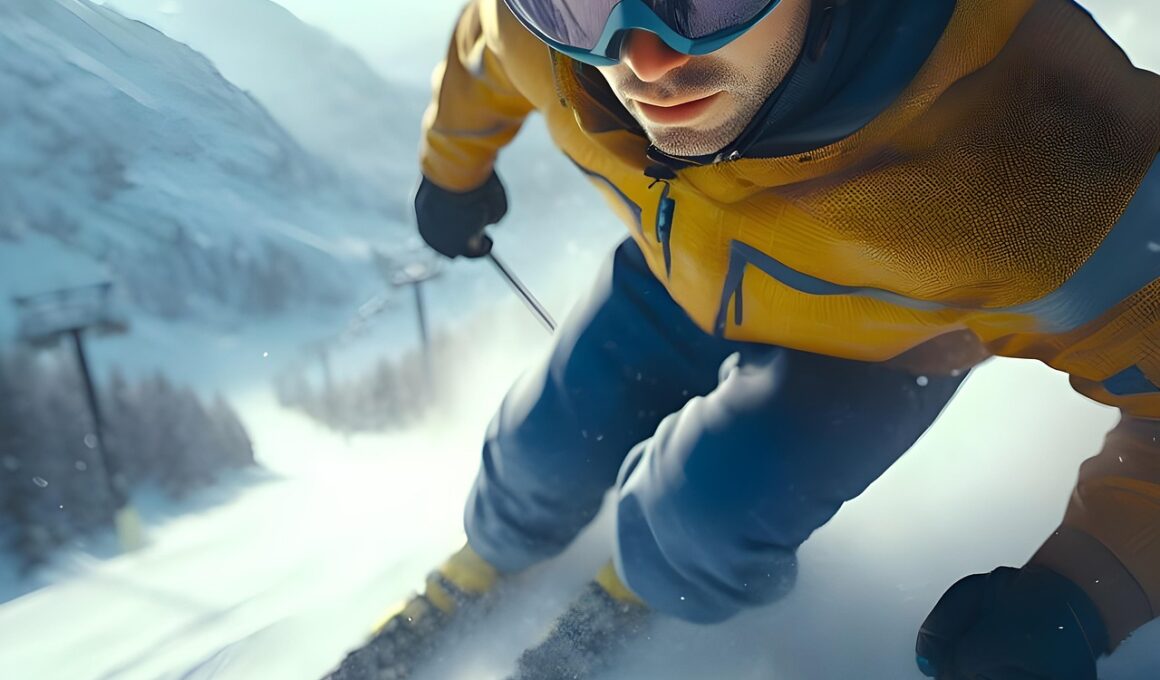Using HDR Techniques in Bright Snowy Environments
Shooting in bright snowy conditions can pose unique challenges for photographers. The intensity of sunlight reflecting off the snow can lead to loss of detail in shadows and highlights. To combat this issue, employing High Dynamic Range (HDR) photography is key. HDR techniques help photographers capture a wider range of luminosity, ensuring detailed images across all areas of a scene. By merging multiple exposures – one underexposed, one correctly exposed, and one overexposed – you can create a balanced photograph that captures the beauty of a winter landscape. Start by using a tripod to stabilize your camera and prevent any motion blur between shots. This equipment is crucial for getting sharp images in HDR photography. Use a camera with bracketing capabilities to automatically take shots at various exposure levels. Don’t forget to adjust your aperture settings, as a smaller aperture can improve depth of field and detail. Also, consider using image editing software to combine the exposures effectively and control the final outcome. Remember, editing is just as important as taking the photo, especially in challenging conditions.
Another important aspect of HDR photography in snowy environments is understanding light management. Bright snow reflects light dramatically, which can trick metering systems. When your camera determines the exposure, it can often fall victim to overexposure, resulting in washed-out areas in your images. Therefore, manual adjustments and careful composition become essential. Before starting your shoot, conduct a meter reading on the snow where you intend to capture your photos. Ensuring that you understand the tonal range of your scene is vital. Avoid relying solely on your camera’s auto settings, as they may not accommodate the complexities present in bright snow conditions. When capturing multiple exposures, ensure that your settings remain constant throughout the process to maintain consistency in your final HDR image. Snow can appear grayish in HDR images if not processed correctly, so pay attention to white balance settings during shooting and post-processing. The right adjustments can prevent color casts and ensure that your winter photos appear vibrant and inviting. HDR allows you to unlock beautiful possibilities even in harsh brightness.
Editing Techniques for HDR Images
Editing plays a pivotal role in achieving a successful HDR photograph, particularly in snowy settings. After taking multiple exposures, utilize software like Adobe Lightroom or Photoshop to merge the photos seamlessly. Begin by importing your images and aligning them to ensure consistent depth and perspective. The software will allow you to create a single HDR image, combining the details from each photograph. Pay careful attention to histogram levels as they will help highlight areas of your image that may still be too light or too dark. Once you’ve merged the images, proceed to fine-tune brightness, contrast, and color saturation for the best visual effect. It’s crucial to not overdo adjustments; too much editing can lead to unnatural results. Aim to maintain the integrity of the snow’s natural color and texture. Incremental changes can yield more organic outcomes. Additionally, explore local adjustments like brushes or gradients to enhance specific areas, thereby enhancing depth without affecting the entire image. Strive to present an image that invites viewers to experience the snowy landscape through your lens.
Using HDR creatively allows you to showcase dramatic contrasts in your winter sports photography. Snow-covered mountains, ski tracks, and energetic athletes can all benefit from this technique. Sports photography often demands quick reflexes, but capturing the right lighting conditions in winter sports can be pivotal to a stunning shot. Utilize HDR to highlight the dynamic movement of skiers and snowboarders as they race across the terrain. Effectively displaying shadows and highlights can emphasize the excitement of the moment. When using HDR, consider the impact of motion blur versus the crispness of static elements. A quick shutter speed may be necessary to catch fast-moving subjects without losing energy in your image. Conversely, integrating some motion blur through slower shutter speeds can give a sense of speed and fluidity. Make interactive compositions by including foreground elements, such as trees or snow banks. Balancing dynamic movement against the serene winter landscape enhances storytelling. Ensure that each shot is well-composed, leveraging the expansiveness of your snowy surroundings to excite your viewers.
Proper Gear for Winter Sports Photography
Equipping yourself with the right gear enhances the HDR photography experience in winter sports. It is essential to have a sturdy camera that can handle temperature fluctuations and icy conditions. DSLR or mirrorless cameras are typically preferred due to their dynamic range and bracketing features, which are necessary for HDR techniques. Consider weather-sealed equipment that can endure snow or moisture without compromising functionality. A variety of lenses can also expand your options, ranging from wide-angle lenses for expansive landscapes to telephoto lenses for close-up action shots. Additionally, investing in protective filtering for your lens can help prevent flare and snow distortions. A tripod is non-negotiable, as it allows for stable shooting and optimal clarity across multiple exposures. Don’t forget a spare set of batteries, as cold weather can drain battery life quicker than expected. Finally, ensure your editing software is up to date for capturing every facet of your winter photography adventure. Proper gear not only supports your HDR needs but also ensures that you are prepared for the unpredictable nature of winter conditions.
Winter conditions can affect the performance of gear, so practicing maintenance techniques is advisable. Regularly inspect your camera and lenses to prevent moisture from developing inside your equipment. After shooting in snow, keep gear wrapped and dry during transitions to warmer temperatures to avoid condensation. Use silica gel packets in your camera bag for moisture control. Having lens cleaning supplies, such as microfiber cloths and brushes, is indispensable, as snow can leave residue on your gear. Remind yourself to check batteries frequently, especially with prolonged exposure to cold. As a winter sports photographer, you want to ensure that every moment captured is as beautiful and dynamic as possible, so being well-prepared is crucial. Collaborate with participants to schedule shoots during the most flattering light moments, such as golden hours, as this can dramatically affect your HDR outcome. With thoughtful preparation and attention to photographic techniques, snow sports photography can become both enjoyable and rewarding. Utilize HDR creatively while taking stunning snow images that showcase the beauty of the winter sports realm.
Final Thoughts on HDR in Snowy Environments
In conclusion, incorporating HDR techniques into your winter sports photography can elevate your work to new heights. Snowy landscapes present unique challenges, but understanding exposure, proper gear selection, and effective editing can yield stunning results. HDR photography allows you to capture balanced images filled with detail and vibrancy, showcasing the beauty of the snow without losing depth in highlights and shadows. By practicing thoughtful composition and utilizing the breadth of your equipment, your photos can transform from ordinary to extraordinary. Experimentation is key; don’t hesitate to try various techniques and settings that may enhance your photographic eye. Capture the thrill of the slopes as athletes glide, jump, and race while preserving the stunning scenery that surrounds them. Each shot taken is an opportunity to convey a story. With HDR, you can emphasize not just the action but the beauty that surrounds it, creating captivating images that catch the viewer’s attention. Embrace the challenges that come with winter sports photography, and watch as your skills grow. With dedication and creativity, anyone can become an excellent winter sports photographer.
Preparing to photograph, please consider perspective and composition when using HDR techniques. Snow provides a gorgeous backdrop, lending itself to various angles for capturing breathtaking shots. Be mindful of your surroundings and how they interact with the light; embrace the challenge of contrasting textures. The reflections of snow can add a unique dynamic to compositions. Feeling the texture of snow through your lens or through the atmosphere can enrich them visually. When selecting your frame, layer foreground, middle ground, and background elements to add depth to your images. Make sure to be wary of distractions in your shots, which can detract from the main subject, whether it’s an athlete or a stunning landscape. Use leading lines or interesting shapes to draw viewers into the scene. Engage with your subjects, whether they are skiing or snowboarding; genuine emotions captured in these instances resonate deeply. Furthermore, practice patience; waiting for the right moment can yield extraordinary results. The collective harmony between snow and movement can create a mesmerizing atmosphere. When all elements align perfectly, your HDR imagery will not only tell a story but also draw viewers into the breathtaking beauty of winter sports.


